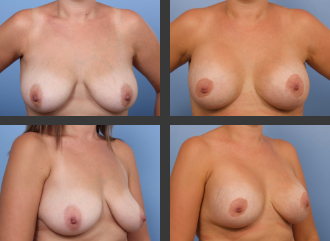Descending breasts and breast volume loss are common changes after breastfeeding or weight loss. Breast lift or mastopexy surgery is suitable for women with nipples and areolas that point downward or have become enlarged over time. The surgical procedure is also suitable for those with asymmetrical breasts, where one is significantly lower than the other, and for those experiencing physical discomfort or skin irritation due to descending breasts.
Every woman is different and has a unique anatomy. Some patients may need more than a breast lift to address their specific concerns. A breast lift can be combined with breast augmentation, but the discretion is up to the individual and Dr Andrew Broadhurst’s recommendation.
What does it involve?
A breast lift or mastopexy can address descending breasts that are often a result of breastfeeding, weight loss, or ageing. The procedure involves removing excess skin, reshaping the breast tissue, and repositioning the nipple to the middle of the breast. This will lift the reshaped breast to a higher position.
Who are the suitable candidates for a mastopexy?
Suitable candidates for the procedure may want to address the following breast changes:
These are the most common reasons why women consider a breast lift:
- Breast volume loss due to ageing, pregnancy, breastfeeding, or significant weight loss
- Breasts that are descending
- Nipples and areolas that point downwards or are located far below the breast crease
- Breasts that appear different – one may be firm and well-positioned, whereas the other is not.
- Breasts that are unequal in size or are relatively small
Breast Lift with Dr Broadhurst
“I pride myself on the individual care and support I provide each of my patients. From your first consultation, I will work one-on-one with you to tailor a treatment plan to suit your body.”

Consultation
Your Initial Consultation
During your initial consultation, Dr Broadhurst will ask you questions about your medical history, discuss any pregnancy plans, discuss your treatment plan, and outline what you can expect after the surgery and early recovery.
Your Second Consultation
You will then see Dr Broadhurst for a second face-to-face consultation at our Brisbane, Sunshine Coast, Hervey Bay, or Bundaberg locations, depending on which area is closest to you.
This appointment ensures that you completely understand the procedure and gives you a chance to ask any further questions. Dr Broadhurst can help provide informed answers about breast surgery and address any concerns you may have.
Procedure
What to expect during your procedure?
A breast lift is performed under a general anaesthetic. Depending on the complexity of the surgery, it takes roughly 1.5 to 2 hours to complete. Dr Andrew Broadhurst will remove excess skin, reshape your breast tissue, and lift it higher onto your chest. All incisions are closed with internal dissolving sutures, and dressings are applied.
Depending on the extent of your physical activity, you should fully recover within one to two weeks. The location of incisions will depend on the size and shape of your breasts, the amount of skin and tissue to be removed, and Dr Andrew Broadhurst’s recommendations and preferences.
Breast Lift Techniques
Four methods may be used to lift your breasts, including:
Crescent Lift

This technique only involves one incision made halfway along the top outer edge of the areola. A small amount of tissue is removed, and the bottom of the incision is lifted to meet the top, elevating the breast and nipple to a higher position. This method is suitable for patients with slight breast descent.
Peri-Areolar Lift

This method, known as the ‘doughnut lift’, involves two circular incisions around the areola, one outside the other. Skin and breast tissue are removed between these incisions, resulting in only one scar around the areola. This technique is suitable for patients with mild breast descent or those who want a smaller areola.
Anchor Lift

This method is the most used for women with large breasts. It involves three incisions around the areola, going vertically from the lower edge of the areola to the crease under the breast (infra-mammary fold) and horizontally along the natural curve of the breast crease. This technique is suitable for patients with excess skin and breast tissue.
Lollipop Lift

This method, also known as a ‘vertical breast lift,’ is the most used breast lift technique. It involves two incisions around the areola. The first is made around the outside of the areola. The second is made at the bottom of the areola, going horizontally to the natural breast crease. This type of incision resembles a lollipop.


